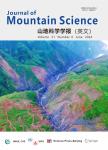Woody Species Diversity and Forest Structure from Lowland to Montane Forest in Hyrcanian Forest Ecoregion
Woody Species Diversity and Forest Structure from Lowland to Montane Forest in Hyrcanian Forest Ecoregion作者机构:School of Biology and Center of Excellence in Phylogeny of Living Organisms College of Science University of TehranP.O. Box 14155-6455 Tehran Iran School of Biology and Center of Excellence in Phylogeny of Living Organisms College of Science University of TehranTehran Iran Department of Cartography Faculty of Geography University of TehranTehran Iran
出 版 物:《Journal of Mountain Science》 (山地科学学报(英文))
年 卷 期:2013年第10卷第4期
页 面:609-620页
核心收录:
学科分类:0709[理学-地质学] 0819[工学-矿业工程] 09[农学] 0303[法学-社会学] 0818[工学-地质资源与地质工程] 0708[理学-地球物理学] 0705[理学-地理学] 0815[工学-水利工程] 0903[农学-农业资源与环境] 0816[工学-测绘科学与技术] 0706[理学-大气科学] 0813[工学-建筑学] 0704[理学-天文学] 0833[工学-城乡规划学] 0713[理学-生态学] 0834[工学-风景园林学(可授工学、农学学位)]
主 题:Alborz Mountains Biodiversity ForestMensuration Hyrcanian forest Disturbance
摘 要:Alborz Mountains host Caspian Hyrcanian forest ecoregion along the northern slopes and forest steppe ecoregion in highlands. Hyrcanian forest covers the southeastern part of Caucasus biodiversity hotspot and is of great biogeographic importance. Altitudinal pattern and correlation between woody species biodiversity (DIV), forest structure ((stem density (DEN), mean basal area (MBA) and mean height class (MHC)) and disturbance (DIS) were explored along 2,4oo m altitudinal gradient in Hyrcanian relict forest, Central Alborz Mountains. Vegetation changes from lowland forest (LoF) to mid- altitude forest (MiF) and montane forest (MoF) in this area. The altitudinal gradient was divided into twelve 200 m elevational belts. Point centered quarter method (PCQM) with 96 sampling points and 83 vegetation samples by plot method (PM) were used to record field data. Shannon-Wiener index and Pearson coefficient were used for diversity and correlation analysis. The results showed that DEN decreased linearly, MBA and MHC showed relatively hump shaped and DIS showed a reverse hump shaped pattern of change along altitudinal gradient. Woody species diversity decreased non-steadily from LoF to MoF. Transitional vegetations of Carpinus-Fagus and Fagus-Quercus represented higher diversity of woody taxa compared to adjacent homogenous communities. Significant correlation was observed between altitude and all parameters: DEN with MBA, DIS and DIV; MBA with DIS; MHC with DIS along with DIV; and DIS with DIV at the study area scale. Surprisingly,correlation between studied parameters differed within each vegetation type. Altitude probably acts as a proxy for human and environmental driving forces in this area. Stability of warm and wet condition, season length, soil depth along with forest accessibility probably influences the altitudinal pattern of the studied parameters. Disturbance affects forest structure and consequently diversity; especially in lowlands. The obtained results recommend



